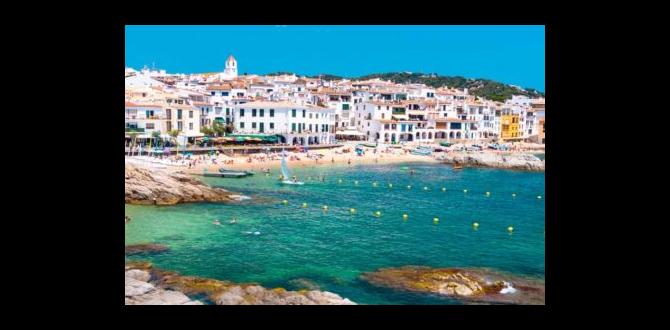Imagine standing in front of a stunning ancient building. You can feel the history whispering to you. This is what makes visiting cultural sites in Spain so exciting. Spain is filled with amazing places that tell stories of the past. Have you ever wondered how many different cultures have shaped this beautiful country?
From the busy streets of Barcelona to the calm hills of Granada, there are many cultural gems to explore. Each site offers a peek into Spain’s rich heritage. Did you know that the Alhambra in Granada is over 700 years old? It’s a perfect mix of history and beauty.
If you love adventure and learning, Spain’s cultural sites are waiting for you. Are you ready to discover the magic of Spain’s history? Let’s dive in and explore these incredible places!
Discovering The Rich Cultural Sites In Spain Today

Cultural Sites in Spain
Spain is rich in cultural sites that tell stories of its vibrant history. From the stunning Alhambra in Granada to the ancient Roman aqueduct in Segovia, each location offers a unique glimpse into the past. Did you know that Spain has 49 UNESCO World Heritage Sites? Imagine walking through medieval streets or marveling at grand cathedrals. Exploring these sites not only teaches us about Spain’s culture but also connects us with the people who shaped it.Iconic Architectural Marvels
Gaudí’s masterpieces in Barcelona. Moorish influences in Andalusian architecture.Imagine a city where buildings look like they’re made of candy! That’s Barcelona, thanks to Gaudí. His works like the Sagrada Família and Park Güell are pure magic, filled with colors and shapes that dance. Did you know Gaudí spent 43 years on the Sagrada Família? Now, if you head south to Andalusia, you’ll see Moorish influence in stunning palaces like the Alhambra. These structures boast intricate designs and calm gardens. They’re like walking through a fairy tale!
| Location | Architectural Style |
|---|---|
| Barcelona | Modernisme (Gaudí) |
| Granada | Moorish |
Historic Cities and Their Cultural Significance
Madrid: A blend of modernity and tradition. Seville: The heart of Flamenco and historical landmarks.Spain is home to vibrant cities that showcase its rich culture. Madrid mixes modern life with old traditions. Visitors can see exciting art in museums and enjoy tasty food. In Seville, Flamenco dances fill the streets, bringing joy and energy. Ancient buildings tell the story of Spain’s past. Together, these cities reveal the heart of Spain’s cultural heritage.
What makes Madrid and Seville important cultural sites?
Madrid offers a mix of modern art and historic charm. Seville is famous for its Flamenco and beautiful architecture. Both cities attract millions of visitors each year, eager to explore their culture.
Key Highlights:
- Madrid: Home to the Prado Museum and Retiro Park.
- Seville: Famous for the Alcázar palace and the Cathedral.
Regional Cultural Festivals
La Tomatina: A unique tomatothrowing festival. Semana Santa: The significance of Holy Week celebrations.In Spain, some festivals are real head-turners! Take La Tomatina, for example. It’s a wild tomato-throwing party in Buñol. You’ll leave looking like a tomato yourself! Then there’s Semana Santa, or Holy Week, filled with emotional parades and stunning floats. People honor their faith and traditions in a colorful way.
| Festival | Description |
|---|---|
| La Tomatina | A fun, messy tomato-throwing festival where everyone gets covered in red! |
| Semaña Santa | A holy week filled with parades, celebrations, and deep meanings. |
So, whether you prefer tossing tomatoes or taking part in solemn celebrations, Spain’s got you covered! Fun fact: La Tomatina started in 1945 and has grown into a world-famous event. So, get your throwing arm ready!
Museums and Art Galleries
The Prado Museum: A treasure trove of classic art. Contemporary art in the Museo Reina Sofía.Step into the world of art at Spain’s famous museums! The Prado Museum is like an art treasure chest. It holds masterpieces by artists like Velázquez and Goya. Imagine seeing paintings that are older than your great-grandma! On the other hand, the Museo Reina Sofía offers a fresh splash of modern art. You can even find Picasso’s famous “Guernica” there! Both museums are fun places where you can admire beauty and maybe even get some ideas for your own masterpieces!
| Museum | Highlight | Art Style |
|---|---|---|
| The Prado | Classic art treasures | Famous old masters |
| Museo Reina Sofía | Modern marvels | Contemporary art |
Traditional Cuisine and Culinary Heritage
Tapas: The cultural significance of shared meals. Regional specialties and their historical roots.Sharing meals in Spain is more than just eating; it’s about bonding. Tapas, those little bites of deliciousness, encourage people to gather, chat, and laugh. So, it’s no surprise they’re a Spanish staple! Each region boasts its own specialties, steeped in history. From spicy chorizo in the north to creamy gazpacho in the south, each dish tells a story. They say, “When in Spain, eat like a Spaniard!” What fiesta will you join next?
| Region | Specialty | Historical Insight |
|---|---|---|
| Andalusia | Gazpacho | Hails from the peasant farmers who blended fresh veggies. |
| Valencia | Paella | Originated from farmers cooking rice with local ingredients. |
| Barcelona | Escudella | A warming stew from Catalonia with pork and veggies. |
Significant Religious Sites
The Sagrada Família and its cultural symbolism. The pilgrimage to Santiago de Compostela.Spain is a treasure chest of significant religious sites. The Sagrada Família in Barcelona is like a giant cake made of stone! It’s famous for its unique designs and represents the heart of spirituality and creativity in Spain. Tourists and locals alike marvel at its intricate towers and colorful stained glass. Then there’s the pilgrimage to Santiago de Compostela. Every year, thousands walk miles to reach this holy site. It’s a journey of faith, fitness, and often an excuse to eat lots of tapas along the way!
| Site | Description |
|---|---|
| Sagrada Família | Symbolizes creativity and spirituality. |
| Santiago de Compostela | Popular pilgrimage destination. |
Local Traditions and Customs
The importance of flamenco dancing in Spanish culture. Festivals celebrating local traditions across regions.Flamenco dancing is a key part of Spanish culture. The rhythms tell stories of joy and sadness. Dancers wear colorful dresses and perform with passion. Festivals in different regions celebrate these traditions. Each festival has its own unique flavor and activities. They bring people together, making them feel proud of their heritage. Here are some famous Spanish festivals:
- La Feria de Abril in Seville
- Las Fallas in Valencia
- San Fermín in Pamplona
These events showcase not only flamenco but also local food, music, and crafts. They keep the spirit of tradition alive in Spain.
Why is flamenco important in Spain?
Flamenco is important because it expresses deep emotions and reflects Spanish history. It connects people and helps them share their stories through music and dance.
Conclusion
In conclusion, Spain is home to many amazing cultural sites. You can explore ancient castles, vibrant festivals, and stunning museums. Each location tells a unique story and showcases rich traditions. We encourage you to visit these sites and learn more about Spain’s history. Check out travel guides or websites to plan your next adventure!FAQs
What Are Some Unesco World Heritage Sites In Spain, And What Makes Them Significant?Spain has many UNESCO World Heritage Sites. One famous site is the Alhambra in Granada. It is a beautiful palace that shows amazing art and history. Another site is the Sagrada Familia in Barcelona. This church has unique designs made by the artist Antoni Gaudí. These sites are important because they tell us about Spain’s culture and history.
How Do Spain’S Cultural Festivals, Such As La Tomatina And Semana Santa, Reflect The Country’S History And Traditions?Spain’s cultural festivals, like La Tomatina and Semana Santa, show its rich history and traditions. La Tomatina is a fun tomato-throwing festival. It celebrates the community spirit and joy of people coming together. Semana Santa, or Holy Week, honors important religious events with parades and processions. These festivals keep Spain’s history alive and let people enjoy their culture.
What Architectural Styles Can Be Observed In Spain’S Famous Landmarks, Such As The Sagrada Familia And Alhambra?In Spain, we can see many cool architectural styles in famous landmarks. The Sagrada Familia in Barcelona shows a unique style called Modernisme, which has lots of curves and colorful details. The Alhambra in Granada is a great example of Moorish architecture, with beautiful tiles and arches. Both places mix art and history, making them special to visit.
How Do Spain’S Diverse Regions Contribute To The Country’S Overall Cultural Heritage, Particularly In Terms Of Language And Customs?Spain has many different regions, and each one has its own special traditions and languages. For example, in Catalonia, people speak Catalan, and they celebrate festivals like La Merce. In the Basque Country, you can hear the Basque language and enjoy unique dances. These differences help make Spain’s culture rich and interesting. We learn so much from each region’s customs and stories!
What Role Do Museums And Art Galleries, Like The Prado And Reina Sofía, Play In Preserving And Promoting Spain’S Cultural History?Museums and art galleries like the Prado and Reina Sofía help us learn about Spain’s past. They show us important paintings, sculptures, and other art. This way, we can understand the culture and stories of Spain. When we visit, we keep these traditions alive and share them with others. It’s like traveling back in time!







